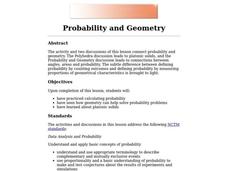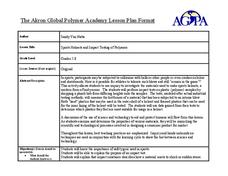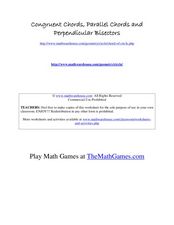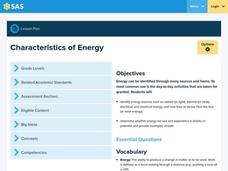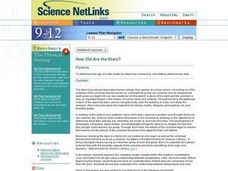Curated OER
What's the Matter? (Experiments)
Students observe a scientific discrepant event, and are then challenged to create experiments to solve the dilemma.
Curated OER
Changing States: Does it Matter
Young scholars participate in experiments to visualize the differences between chemical and physical changes. They attempt to detect the five characteristics of a chemical change.
Curated OER
Hero Portrait done in Micrography
Students discuss heroes, choose hero of their choice, write short biographies, and create drawings of heroes.
Curated OER
Chinese Shadow Puppets
Students explore Chinese culture by performing a shadow puppet play. They create the puppets, develop a script, and rehearse and perform a play which illustrates an understanding of Chinese stories and traditions.
Curated OER
Probability and Geometry
Students explore the ways Geometry can help solve probability problems. Students describe platonic solids and practice calculating probability using an online resource. They construct dice with various numbers of sides to demonstrate...
Curated OER
Electricity--More Power to Ya!
Fourth graders use research tools to access and synthesize information. They gather and manipulate data using technology. Research and study the components of an electrical circuit. Create a brochure that demonstrates knowledge of how to...
Curated OER
Animal Behavior
Young scholars investigate stimulus-response behavior, learned behavior in animals and innate behavior in animals. In this animal behavior lesson plan, students answer questions about their reactions to a toy cap gun that is fired off in...
Curated OER
Sports Helmets and Impact Testing of Polymers
Students examine the importance of good quality safety gear. In this investigative lesson, students will tests various polymers, collect data, and analyze the data to determine which polymer is best for safety helmets. They will design a...
Curated OER
The Dream Catcher
Students create a dream catcher. In this visual arts lesson, students read the book Dream Catcher and create a dream catcher by using a willow branch, leather string, feathers, and beads.
Curated OER
Aristotle
In this online interactive philosophy worksheet, students respond to 10 short answer and essay questions about Aristotle. Students may check some of their answers on the interactive worksheet.
Curated OER
How Evolution Works
High schoolers discuss the evolution of the eye and how a complex organ can evolve through natural selection. They research genetic variation, adaptation, and sexual selection. They analyze data to determine how beak length of Gal??pagos...
Curated OER
The Martian and the Car
In this living things learning exercise, students determine 5 things about a car that makes it seem like its a living thing and 5 things that prove it is not a living thing. This learning exercise has 10 short answer questions.
Curated OER
Rusting, Burning and Oxygen
In this rusting, burning and oxygen worksheet, students read about chemical reactions and are given diagrams of a rusting bicycle, a burning candle, and a variety of chemical changes. Students make observations and explain the chemical...
Curated OER
Covalent Compounds
In this covalent compounds worksheet, students answer 8 questions about bonding in covalent compounds, covalent bonds, and diatomic molecules. Students draw 2 dot diagrams showing covalent bonding. They answer 4 questions about bacteria...
Curated OER
The Changing Atmosphere of Pluto
In this atmosphere of Pluto worksheet, students use an equation for the orbit of Pluto to determine the semi-major axis, the semi-minor axis, the ellipticity of the orbit, the aphelion and the perihelion. They also determine the...
Curated OER
Congruent Chords, Parallel chords and Perpendicular Chords
In this geometry instructional activity, students solve problems about congruent, parallel, and perpendicular chords and bisectors. There are 9 problems with an answer key.
Curated OER
Characteristics of Energy
Fourth graders view a video and create a KWL to identify energy sources. For this energy sources lesson, 4th graders explore the meaning of energy, kinetic energy, potential energy, thermal energy, radiant energy, and electrical energy....
Curated OER
Animals of the Fire Ice
Students examine ocean life by identifying methane hydrates. In this ocean life lesson, students research organisms that live in the coldest, deepest parts of the ocean and live off methane hydrates. Students create a group...
Curated OER
The Designed World
Learners study the classification system used in a library. For this sorting and classification lesson, students visit their library and define the classification system in place. Learners discuss the sorting method and then come up with...
Curated OER
Gaslight Ad
Students analyze historic advertisement for clues and information about the past. They synthesize and think critically about advantages and disadvantages of new products and again understanding of how people perceive "the comforts of home"
Curated OER
Water Cycle (Grades 2-4)
Students demonstrate their understanding of the water cycle and how it effects the environment by graphically depicting and describing the water cycle.
Curated OER
How Old Are the Stars?
Young scholars determine the age of a star cluster by observing, measuring, and plotting astronomical data. They examine the Jewe lbox cluster, located within the southern constellation Crux and determine its age.
Curated OER
Cancer Causes
Students explore why people get cancer. They explore human cells by taking a close examine their own. take a small sample of the epithelial cells that line the inside of their mouth. They glimpse how scientists investigate inside cells.
Curated OER
A STEP IN SPECIATION
Students place different subspecies of a CA salamander are placed on grid map of CA according to where samples were collected. Then discuss patterns of their distribution, their likely evolutionary relationships, and probable sequence of...




